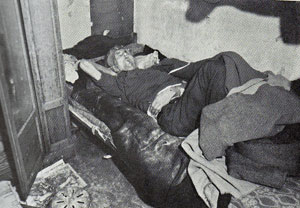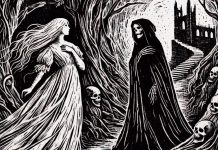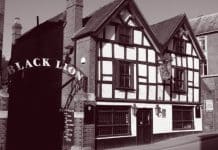Demetrious Mykicura’s fear of vampires lead to his death in the infamous “Vampire of the Villas” case in Stoke-on-Trent in 1972, says PAUL ADAMS
On 24 November 1972, a young Staffordshire police constable, 22-year-old John Pye was called to No.3 The Villas, a gloomy boarding house on the south-west side of Stoke-on-Trent. The landlady and several of her tenants had become concerned about the wellbeing of one of the lodgers, middle-aged Polish pottery worker Demetrious Mykicura (or Myiciura), who had not been seen for several days.
Forcing open the door of his tiny first floor room, PC Pye switched on his torch and found himself stepping into what appeared to be a scene out of a nightmare.
Mykicura, aged 56, who had lived in England for the previous 25 years since the end of World War II, was lying dead under the blankets on the small single bed; there appeared to be no obvious cause of death and initially it seemed as though the potter had simply died in his sleep.
The Pole had apparently been so frightened of electricity that he had removed the light bulb from the ceiling rose, with the result that PC Pye was forced to carry out his initial examination by torchlight.
His landlady, Mrs Rodziewicz, told the policeman that Mykicura had also been terrified of vampires and as he looked around the shadowy room it became clear that the dead man had turned his cramped bedroom into a veritable fortress against them: crosses and crucifixes had been hung on the walls; salt was scattered over the furniture and the bedclothes, while two small bags of salt were found in the bed itself, one between Mykicura’s legs, the other on the pillow next to his head.

Opening the window, PC Pye saw on a flat roof close to the window sill an inverted washing bowl under which was a bizarre cake of human excrement mixed with garlic, as though the frightened man had been intent on warding off some form of invasion from outside.
An inquest was opened into Mykicura’s death and a subsequent post-mortem revealed that death had been due to asphyxiation: what at first appeared to be part of a pickled onion was found lodged in his throat, but John Pye, who had carried out research into vampirism at the local library, told the coroner that salt and garlic were traditional Eastern European repellents against vampire attacks.
When the pickled onion was re-examined by the pathologist at the coroner’s request it was found to be a clove of garlic.
Mykicura, who had been born in 1904, had been displaced by the German occupation of Poland and forced to flee the country where his wife and the rest of his family were killed.
The verdict of the coroner was that the pottery worker had been genuinely afraid of an attack by vampires and had not been trying to kill himself.
‘As a final desperate measure to ward off the vampires, this wretched man had slept with a clove of garlic in his mouth, and the garlic had choked him to death,’ Daniel Farson, one of the first commentators on the case wrote in his 1975 book, Vampires, Zombies and Monster Men, ‘So in a roundabout way, the vampires did get him in the end’.
Vampire of the Villas fact not fiction
If this eerie modern scenario of one man’s lonely and ineffective fight against the forces of darkness seems strangely familiar, it is because it surely gives a chilling reality to some of horror film and literature’s most iconic moments.
In 1954, the American writer Richard Matheson brought Stoker’s Dracula into the atomic age with his apocalyptic vampire novel, I Am Legend, describing a world destroyed by a global pandemic amidst which a solitary survivor battles for life in a Los Angeles suburb transformed into a living Bosch-like nightmare.
Matheson’s Robert Neville, like Mykicura, was forced to spend the night hours barricaded inside an improvised fortress and like the Polish potter was ultimately unable to escape his inevitable fate.
More than Matheson’s I Am Legend however, the sad and disturbing story of the Vampire of the Villas easily recalls one of the famous moments from David Seltzer’s The Omen, filmed by director Richard Donner in 1976 barely four years after the strange events in the potteries of Staffordshire.
The tormented Father Brennan, played by ex-Doctor Who character actor Patrick Troughton, is the man whose cramped bedsitting room, papered with pages from the Bible and festooned with crucifixes and holy icons, the world of Demetrious Mykicura most resembles, as he attempts to convince American politician Gregory Peck that his adopted son Damien is a veritable child from Hell.
In 2012, the events of Demetrious Mykicura’s death were the basis for a feature length Gothic Victorian-era vampire film, Blood and Bone China, by film and music video director, Chris Stone. What took place to precipitate his doomed fight against the perceived forces of the undead remains a mystery to this day.
PAUL ADAMS is a Luton-based paranormal historian, writer and publisher. His latest is Written in Blood, a new examination of vampires and vampirism in British literature, film, music and television together with real-life cases including the Highgate Vampire, the Gorbals Vampire and Stoke-on-Trent’s Vampire of the Villas. Contains in-depth chapters on Stoker’s Dracula, the history of Hammer Films, Gothic and modern vampire literature and vampire-related murderers. Publication date is 1st July 2014 and can be pre-ordered from Amazon. He has written several other books on British ghosts and hauntings including Borley Rectory. Find out more at pauladamsauthor.co.uk Follow him @pauladamsauthor









I am probably the only living person who knew Mikicura. I lived at the house with my mother until 1971 when I moved to London. He lived as a lodger at my mums house rent free, on condition that he kept the upstairs clean as my mum had several lodgers most of them Polish ex miners, who had come here after the war and worked in the Pits.The poor man had had a bad time of it during the war which had left him no all there.He was a quiet man and a loner and as he got older he began to develop mental health problems, for example once there was a electrical short in the house which made the water taps give a slight shock on touching them, my mum had this fixed but Mikicura insisted it was the government doing this to stop people using too much water, hence he didn’t trust electricity any more. My mum always regretted. not sorting some medical help for him before it was too late. The only up side to the whole affair was that the room had to be gutted and contents destroyed because he had got it into such a state, and when my mum stated to dismantle the wardrobe she found nearly 1000 pounds taped to the back of it. This paid for the redecoration of the top 3 rooms.
Ken Rodziewicz